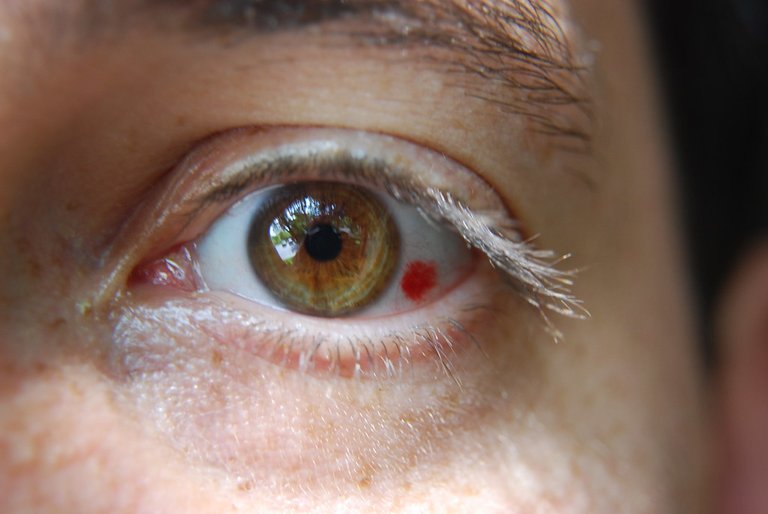You wake up one morning and you find a blood spot on the eye of your sister or loved one, and you want to begin to panic, maybe you should take a chill pill a little bit because it may just be a case of SUBCONJUNCTIVAL HEMORRHAGE. So, what is this term and why does it happen to humans?

flickr.com
Subconjunctival hemorrhage is a term used for the description of a broken blood vessel bleeding on the eye surface. The conjunctiva is the clear membrane that lines the inner part of the eyelid and covers the white part of the eye, it contains several tiny blood vessels which can break easily. When this break happens, there is a chance of blood leaking under the conjunctiva, it is the presence of this blood that causes the white part of the eye to become bright red.
The presence of subconjunctival hemorrhage has blood trapped in the conjunctiva, so it does not move and it is impossible to have it wiped away. Vision is however not affected since the blood is not on the cornea or inside the eye. The red spots caused by subconjunctival hemorrhage can look really scary, but in most cases, there is no associated symptom or need for any form of treatment as it would naturally disappear within a few weeks.
Once there is no other associated symptom aside from the red spot in your eyes, and there is no form of swelling or pain that affects vision in the long run, you may just keep calm. Most people with subconjunctival hemorrhage will not even know until they stare at the mirror or someone else tells them, there is a chance of experiencing mild irritation, but there should be no form of discharge at all.

flickr.com
Certain health conditions and other forms of activities could raise the blood pressure in the veins, which could cause the vessels in the eyes to break. Some examples of the conditions are;
Injury to the head or the eye, could also be a form of infection.
Straining which includes sneezing, coughing, vomiting, or an intense train while using the toilet.
Wearing contact lenses.
Medications like blood thinners and cancer drugs known as interferon.
Lifting, bending forward, or pushing.
High blood pressure.
Blood clotting disorders.
Diabetes.
Having a health complication from subconjunctival hemorrhage is very rare, but if your condition is a result of trauma, your doctor will need to evaluate your eye to ensure there is no further case of complication.
There are however risk factors for subconjunctival hemorrhage that could trigger its occurrence;
Eye surgery: People with experience of eye surgery, like cataract surgery, are also at an increased risk of subconjunctival hemorrhage.
Wearing contact lenses: People who put on contact lenses are at a risk of subconjunctival hemorrhage. This disease could result in friction and dryness which could lead to inflammation and broken blood vessels.
Age: People who are older than 65 years are at more risk of having subconjunctival hemorrhage, especially for people who have vascular conditions like diabetes and high blood pressure.
You know it is time to see a doctor when;
You begin to have vision and pain problems.
The red spot in your eye fails to improve after two weeks.
The red eye indication started after rubbing of the eye, taking off contact lenses, or after the experience of an injury.
Re-occurrence of subconjunctival hemorrhage.
Conclusion.
Subconjunctival hemorrhage is nothing to worry about except you begin to experience other symptoms like itching, pain, and irritation. However, if the redness of the eye does not disappear after two weeks, you need to speak to your doctor to run necessary checks on you to verify the status of the health of your eyes.
Read More.
https://www.medparkhospital.com/en-US/disease-and-treatment/subconjunctival-hemorrhage
https://www.ncbi.nlm.nih.gov/books/NBK551666/
https://my.clevelandclinic.org/health/diseases/17713-subconjunctival-hemorrhage
